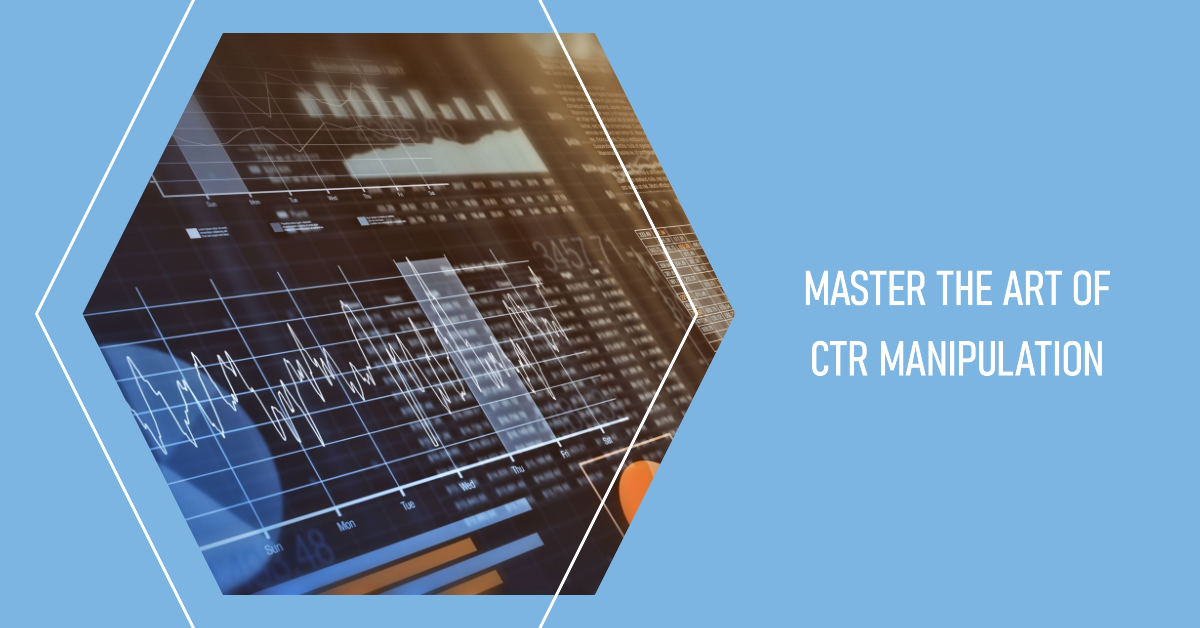Unlock the Potential of CTR Manipulation for Improved Project Efficiency
Checking out the world of CTR control unveils a world of possibilities for marketing experts looking for to elevate their project results. As the trip to unwind the details of CTR adjustment begins, the potential for transformative results waits for those who risk to navigate this nuanced landscape.
Recognizing CTR Control Techniques
In the realm of electronic advertising and marketing, understanding CTR manipulation strategies is vital for optimizing project efficiency. Click-through rate (CTR) is a key metric that gauges the performance of your ads in creating clicks. By adjusting CTR, marketing professionals can influence advertisement performance and ultimately enhance project results.
One typical strategy used for CTR manipulation is ad copy optimization. Crafting compelling advertisement duplicate that reverberates with the target audience can lead to higher CTRs (CTR Manipulation). Consisting of strong calls-to-action, appropriate keyword phrases, and distinct marketing factors can entice customers to click the ad
One more strategy is bid adjustments based upon CTR efficiency. Systems like Google Ads use Quality Score, which thinks about CTR to name a few aspects, to establish advertisement ranking and cost-per-click. By monitoring and adjusting proposals based upon CTR data, marketers can improve ad visibility and reduce prices.
Furthermore, A/B testing different ad variants can aid identify which components drive greater CTRs. Checking descriptions, images, and headings can supply useful insights right into what reverberates finest with the audience, permitting notified optimization choices.
Comprehending these CTR control techniques is vital for digital online marketers looking to enhance project performance and drive meaningful outcomes.
Applying Strategic CTR Optimization
To successfully execute calculated CTR optimization, digital marketers have to take advantage of a combination of data-driven understandings and targeted modifications to improve project performance. By analyzing vital metrics such as click-through rates (CTR), involvement levels, and conversion rates, marketing professionals can determine locations for enhancement and improve their techniques as necessary. One necessary aspect of critical CTR optimization involves performing A/B screening to compare different advertisement creatives, headings, or calls-to-action to establish which elements reverberate ideal with the target audience. Furthermore, optimizing ad placement, organizing, and targeting specifications based upon audience habits and preferences can considerably influence CTR efficiency.
Furthermore, executing keyword optimization and refining ad copy to straighten with customer intent can enhance significance and drive higher click-through rates. Leveraging target market segmentation and individualized messaging customized to specific demographics or passions can also boost CTR efficiency. By continuously checking and readjusting projects based on efficiency data, marketers can fine-tune their approaches for optimal results and maximize the effect of CTR adjustment on general project success.

Leveraging CTR for Raised Conversions
Making use of click-through price (CTR) as a crucial metric in electronic advertising can act as a powerful driver for boosting conversion prices. A high CTR indicates that the advertisement or content is resonating well with the target market, driving even more website traffic to the internet site. By leveraging CTR to increase conversions, marketing professionals can focus on maximizing their campaigns to bring in competent leads who are more probable to purchase or take a desired action.
To utilize CTR effectively for raised conversions, it is vital to examine the efficiency of different ads, search phrases, and targeting methods. By determining which elements drive higher CTRs, marketing experts can customize their campaigns to bring in the ideal target market and motivate them to convert. In addition, A/B testing can aid in refining advertisement copies, visuals, and calls-to-action to webpage improve CTR and ultimately drive even more conversions.

Evaluating Influence of CTR on Projects
Building on the structure of leveraging CTR for enhanced conversions, an essential facet of enhancing electronic advertising and marketing campaigns involves examining the impact of click-through price on general campaign efficiency. Click-through price (CTR) serves as a vital metric in gauging the efficiency of electronic advertising and marketing initiatives. By examining CTR data, marketing experts can acquire beneficial insights right into exactly how well their ads reverberate with the target audience and exactly how engaging they are this link in driving customer engagement.
Understanding the influence of CTR on campaigns is necessary for making informed choices regarding ad creatives, targeting approaches, and budget appropriations. A high CTR indicates that the advertisement is appealing and pertinent to the audience, potentially causing increased conversions and a higher roi. On the other hand, a low CTR might signal issues with advertisement importance, messaging, or targeting, requiring adjustments to improve campaign efficiency.
Fine-Tuning CTR for Better Results
Enhancing click-through rate (CTR) is a basic element of boosting digital marketing campaign efficiency. Fine-tuning CTR entails strategic adjustments to enhance the likelihood of individuals clicking on your ads or web content. One effective method is A/B testing different advertisement creatives, headings, or call-to-action switches to recognize which components reverberate ideal with your target market. By assessing the efficiency of these variants, you can maximize CTR by releasing one of the most engaging elements.
Furthermore, refining audience targeting is critical for boosting CTR. Customizing your ads to particular demographics, interests, or actions can significantly influence click-through prices. Making use of information analytics and client insights can great post to read aid you determine the most responsive target market sectors and tailor your messaging accordingly.
Additionally, enhancing the placement and timing of your advertisements can increase CTR. When your target audience is most active can assist take full advantage of engagement and CTR, trying out with various ad positionings on various systems and identifying peak times. Continually keeping an eye on and changing these aspects based on efficiency data is crucial to tweak CTR for better project results.
Final Thought
In final thought, unlocking the capacity of CTR manipulation with calculated methods like A/B screening and key phrase optimization can greatly improve campaign efficiency. By continually analyzing information and making real-time adjustments to advertisement messaging, marketers can improve click-through rates and drive greater engagement. This polished strategy not only improves presence and decreases expenses yet also causes raised conversions and a stronger return on investment.
By controling CTR, marketers can influence ad efficiency and eventually improve project results. CTR Manipulation.

Understanding the influence of CTR on projects is crucial for making informed choices pertaining to advertisement creatives, targeting methods, and budget plan allotments. On the other hand, a reduced CTR might indicate issues with ad importance, messaging, or targeting, needing modifications to improve project efficiency.